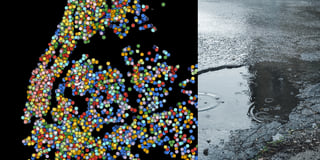Why do Swiss people die?
Hi, I’m Luc, engineer in the visualization team. For this Weekly Chart, I’m remembering the conceptual artist Christian Boltanski, who died in 2021, who once asked a provocative question: Why do Swiss people die?
In the 1990s, the artist Christian Boltanski created La réserve des suisses morts, a series of installations using portraits from the obituary section of a Swiss local newspaper. He blurred the portraits and made them bigger than life to anonymize faces and highlight not specifically their Swissness, but their humanity. When asked why, in fact, he had chosen Swiss obituaries for the project, he noted that Swiss people "had no historical reason to die" — but they died nevertheless.
Knowing Boltanski’s frequent references to historical events in his installations, he might have been alluding to the famous neutrality of Switzerland in geopolitical conflicts, raising the rather philosophical question of not why people die, but why they live, or what they are ready to die for. I chose here to have a very factual look at the causes of death in Switzerland, as a peaceful country, and what can be done about it.
In recent history, death in Switzerland has been rather consistent. Cancer and cardiovascular diseases have been the leading causes of death since 1970; respiratory problems and dementia follow. COVID-19 made a notable appearance in 2020. Most deaths can be attributed to diseases or bodily malfunctions — traumatic deaths like accidents and suicide represent only a small proportion of the overall picture.
The lost years
The Federal Statistical Office of Switzerland also publishes data about potential years of life lost, which they calculate for everyone who dies before the age of 70. The numbers here look slightly different. Accidents and suicides account for a much higher proportion of premature deaths, so they cause the loss of a lot of "potential" years.
Looking at the evolution of premature deaths, we can celebrate the progress made in medical research. Years lost to infectious diseases like tuberculosis have reduced dramatically, and deaths due to AIDS in particular are nowadays close to zero, a drastic decline since the height of the pandemic in the 1990s. Cancer and cardiovascular diseases have followed a similar path, though they still cause a high number of premature deaths. We can observe that years lost to suicide before age 70 have also declined significantly. In a country where assisted suicide is legal, there is maybe something empowering in the prospect of dying healthy of old age. Years lost to alcoholism and car accidents have also declined — it may be that prevention and overall security have reduced these types of more behavioral deaths.
So why do Swiss people die?
In a country with “no historical reason to die,” violent deaths are indeed small and political violence even rarer, which is fortunate. But is Switzerland alone in this situation? In fact, this aligns with global data on causes of death: Interpersonal violence (including wars and terrorism) caused less than 1% of worldwide deaths in 2019, according to Our World In Data, and accidents caused 5.4%.
In a period where the news cycle is full of war rhetoric — or, some would say, reasons to die — and ghastly death tolls are reported daily, I wanted to pay a tribute to an artist who dedicated a lot of his work to remembering the Holocaust, and always questioned what it means to be human. Because maybe the only good reason to die — and to live — is just that, to be human.
That’s it for this week! If you missed it last week, I highly recommend Michi’s Weekly chart who investigated another very human aspect of life, and definitely a good reason to live: dating!



